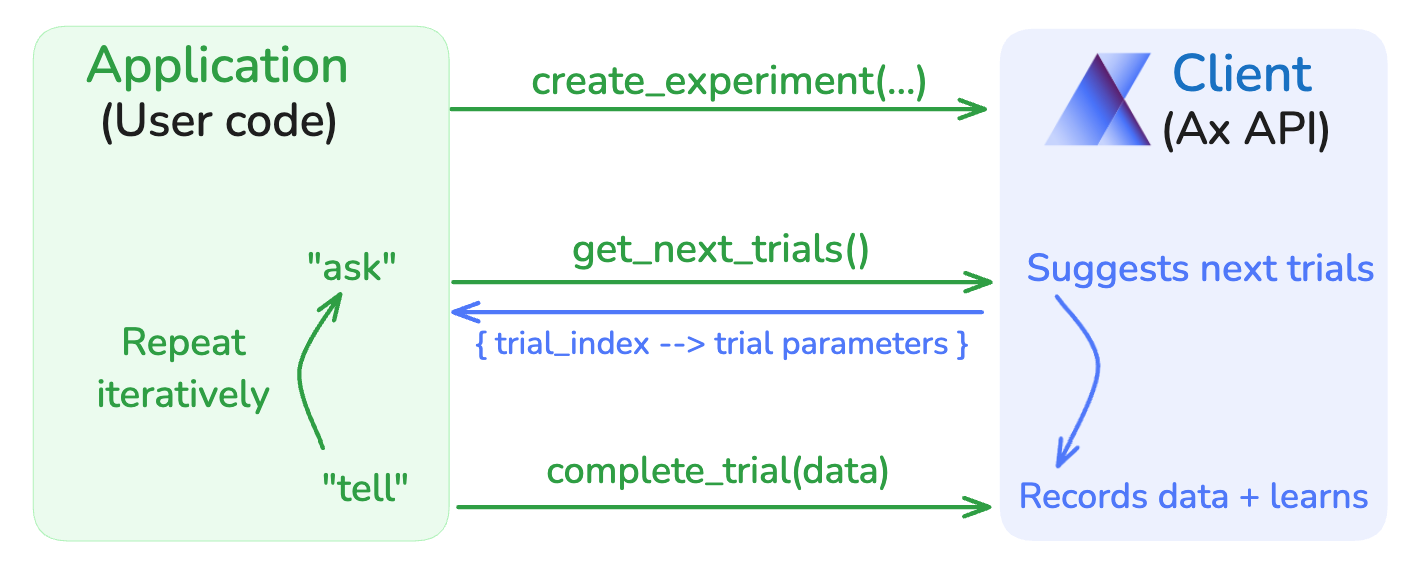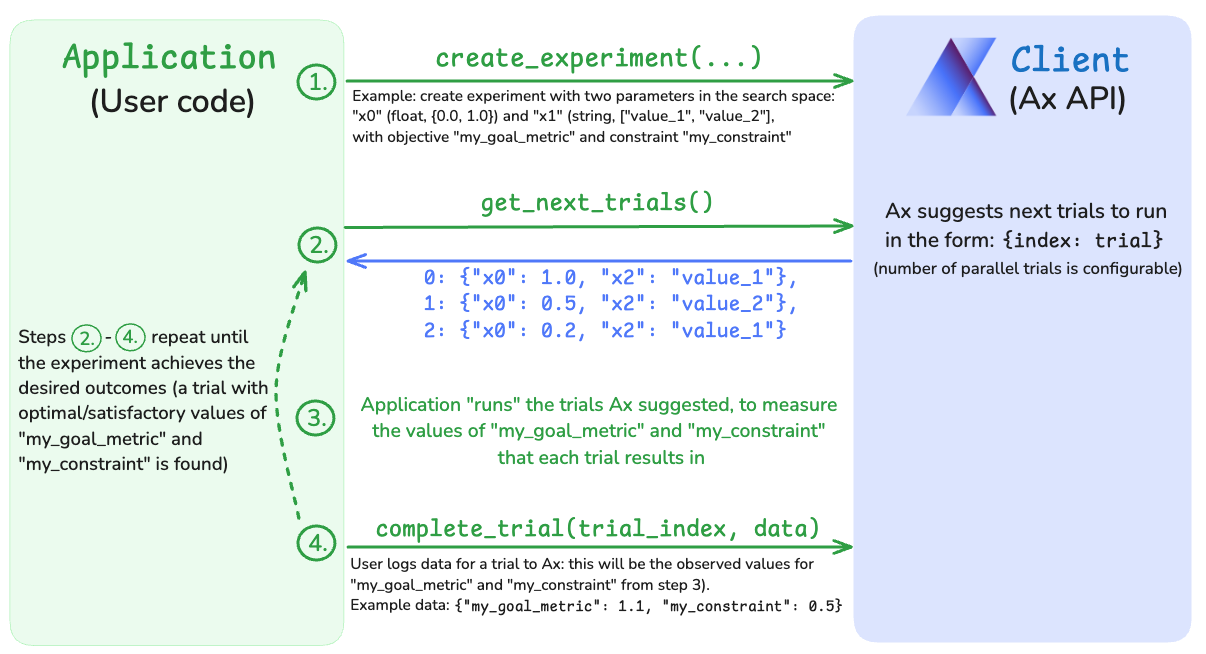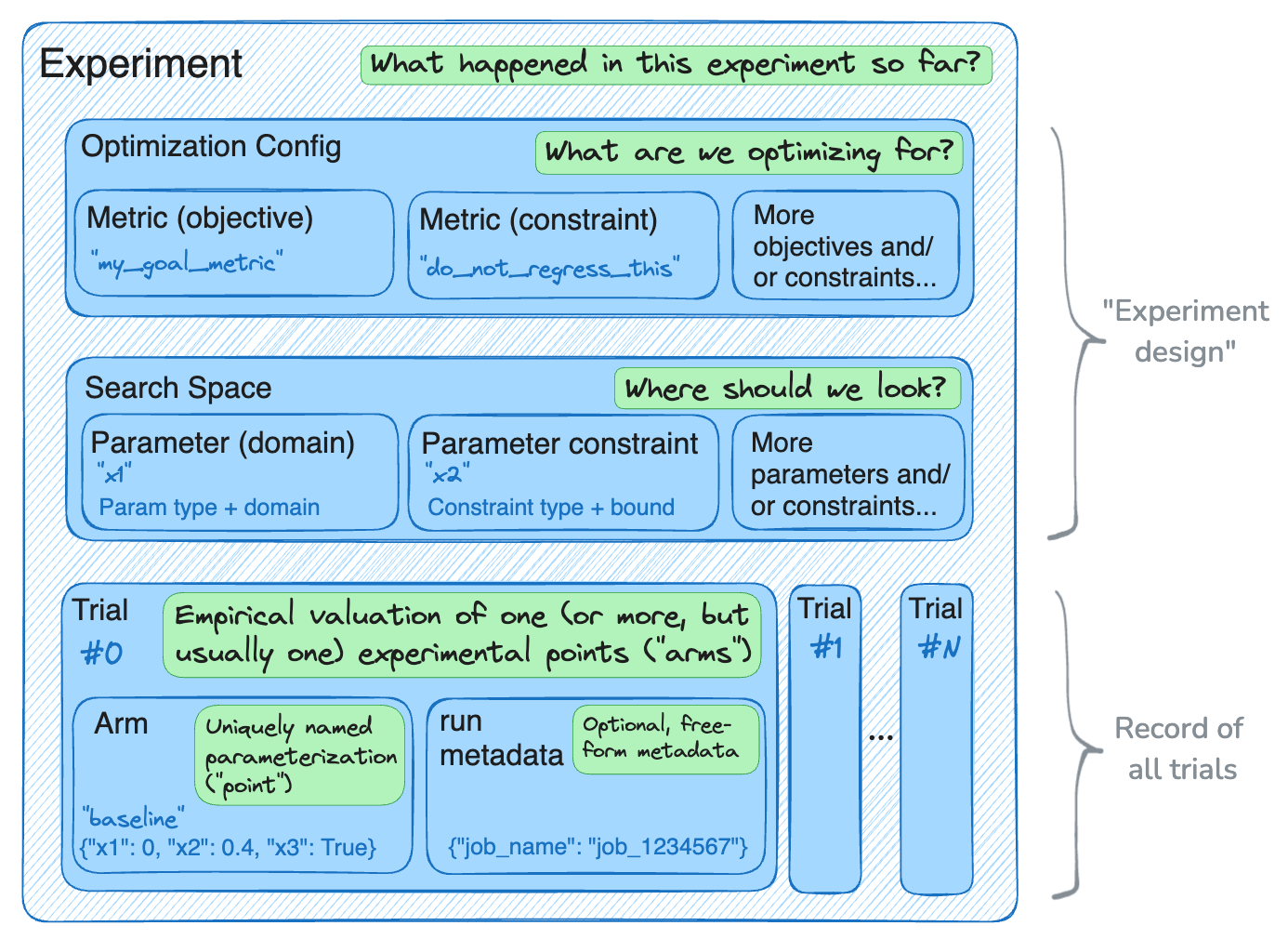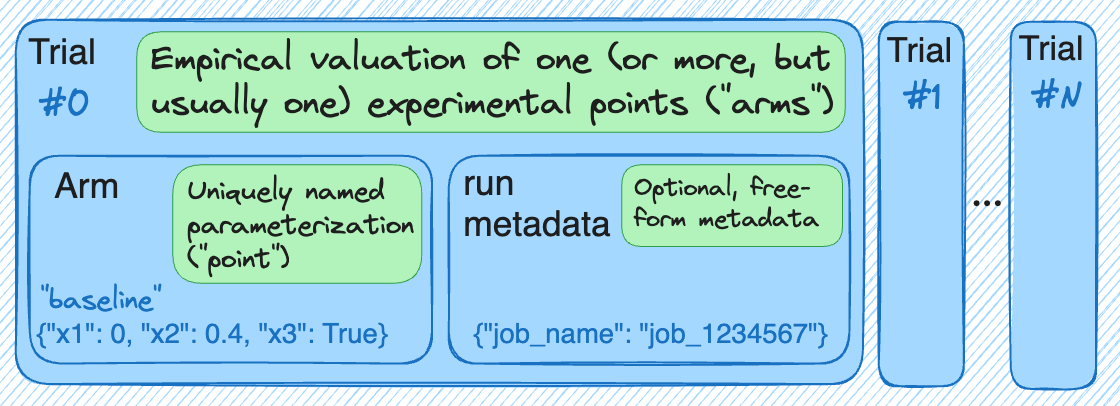This document discusses non-API components of Ax, which may change between major library versions. Contributor guides are most useful for developers intending to publish PRs to Ax, not those using Ax directly or building tools on top of Ax.
Experiment and its components: Trial, Arm, SearchSpace, OptimizationConfig
As we discuss in Intro to Adaptive Experimentation, every optimization in Ax is an iterative process where we:
- Generate candidate datapoints to evaluate (represented by
Trials) - Learn from datapoints we have observed
- In order to find an optimal point (
Armin Ax) by balancing:- exploration (learning more about the behavior of outcomes (
Metrics) in response to a change inParametervalues) - and exploitation (leveraging the knowledge we gained, to identify likely
optimal points/
Arms).
- exploration (learning more about the behavior of outcomes (

Overview
In the Ax data model, this process is represented through three high-order components:
Experiment: keeps track of the whole optimization process and its state,GenerationStrategy: contains all the information about what methodology Ax will use to produce the nextArms to try in the course of theExperiment,Orchestrator(optional): conducts a full experiment with automatic trial deployment and data fetching given anExperimentand aGenerationStrategyobjects (and a set of optional configurations that make the orchestration flexible and configurable).
Users interact with Experiment and GenerationStrategy objects through
methods like Client.get_next_trials and Client.complete_trial), and
optionally an Orchestrator with Client.run_n_trials. The iterative process
of using the Client looks like this in more detail:

We recommend avoiding interacting with the Experiment object directly unless
developing Ax internals (opting to interact with it through Client instead),
but understanding its structure can help conceptualize all the data tracked and
leveraged in Ax.
Experiment
An Ax Experiment is composed of:
- A collection of indexed
Trials (orBatchTrials, more on these below), each of which contain one or moreArms (representing a point that was "tried" in the course of theExperiment).- Each trial records metadata about one evaluation of its
Arms, in the form ofData. In a noisy setting, multipleTrials with the sameArms might produce different data; Ax optimization algorithms excel in such settings.
- Each trial records metadata about one evaluation of its
- Information about the
Experimentdesign, e.g.SearchSpaceAx will be exploring andOptimizationConfigthat Ax will be targeting by optimizing objectives and avoiding violation of constraints.

We use the Experiment to keep track of the whole optimization process. It
describes:
- "Where Ax should look" (via
SearchSpace,Parameters andParameterConstraints), - "What Ax should optimize for" (via
OptimizationConfig, composed of one or multipleObjectives andOutcomeConstraints), - "What have we tried so far in this experiment" (via
Trials andDataassociated with each of them), - Optionally "How do we run each trial and get its data" (via
Runners andMetrics, typically applicable only if using Ax orchestration).
Trial and Batch Trial

An Experiment is composed of a sequence of Trials, each of which has
parameterization(s) (or Arm-s) to be evaluated and a unique identifier: an
index. A Trial is added to the experiment when a new set of arms is proposed
by the optimization algorithm (or manually attached by a user). The trial is
then evaluated to compute the values of each important outcome (or Metric) for
each arm, which are fed into the algorithms to create a new trial.
A regular Trial contains a single arm and relevant metadata. A BatchTrial
contains multiple arms, relevant metadata, and a set of arm weights, which are a
measure of how much of the total resources allocated to evaluating a batch
should go towards evaluating the specific arm. The vast majority of Ax use
cases will only need Trial and not BatchTrial.
A batch trial is not just a trial with many arms! It is a trial for which it is important that the arms are evaluated jointly and together. For instance, a batch trial would be appropriate in an A/B test where the evaluation results are subject to nonstationarity and require multiple arms to be deployed (and gathered data for) at the same time. For cases where multiple arms are evaluated independently (even if concurrently), use multiple trials with a single arm each, which will allow Ax to keep track of them appropriately and select an optimal optimization algorithm for this setting.
Trial Lifecycle and Status
A trial goes through multiple phases during the experimentation cycle:
CANDIDATE-- Trial has just been created and can still be modified before deployment.STAGED-- Relevant for external systems, where the trial configuration has been deployed but not begun the evaluation stage.RUNNING-- Trial is in the process of being evaluated. Trials generated viaClient.get_next_trialsare in this status once the call to that method returns.COMPLETED-- Trial completed evaluation successfully.FAILED-- Trial incurred a failure while being evaluated.ABANDONED-- User manually stopped the trial for some specified reason.EARLY_STOPPED-- Trial stopped before completion, likely based on intermediate data, and with use of an AxEarlyStoppingStrategy.
SearchSpace and Parameters

A search space is composed of a set of parameters to be tuned in the experiment,
and optionally a set of parameter constraints that define restrictions across
these parameters (e.g. “p_a <= p_b”). Each parameter has a name, a type (int,
float, bool, or string), and a domain, which is a representation of the
possible values the parameter can take. The search space is used by the
optimization algorithms to know which arms are valid to suggest.
Ax supports three types of parameters:
- Range parameters: must be of type
intorfloat, and the domain is represented by a lower and upper bound. If the parameter is specified as anint, newly generated points are rounded to the nearest integer by default. - Choice parameters: domain is a set of values (values can be
int,float,boolorstring). - Fixed parameters: domain is restricted to a single value (same types as Choice).
Parameter Constraints
Ax supports linear parameter constraints which can be used on numerical (i.e.
int or float) parameters. These can take a number of forms, including order
constraints (ex. x1 <= x2), sum constraints (ex. x1 + x2 <= 1), or full
weighted sums (ex. 0.5 * x1 + 0.3 * x2 + ... <= 1).
Can I have parameter constraints on my objective?
A constraint can only apply to an objective if Ax is conducting a multi-objective optimization, and we call this special case of constraints "objective thresholds". These provide a "reference point" to Ax multi-objective optimization, informing Ax that trials where value of the objective is "worse" than the objective threshold, are not part of the Pareto frontier we should be exploring. For example, if we are looking to jointly optimize model accuracy and size, we might indicate that even the highest possible accuracy where model size is past a certain "feasibility threshold" (say, the maximum size model that can find onto the target device) is no longer of interest in a given Ax optimization.
What about non-linear constraints?
Non-linear parameter constraints are not supported by Ax at this time, due to challenges in transforming them to the model space.
What about equality constraints?
Ax does not currently support equality constraints. Often, search spaces which
desire equality constraints can be reparameterized to use order constraints
instead. For example if we have a parameters x1, x2, and x3 and want to
constraint x1 + x2 + x3 = 1 the search space can be reparameterized to just
define x1 and x2 with the inequality constraint x1 + x2 <= 1, and the
value 1 - (x1 + x2) can be substituted where x3 would have been used.
OptimizationConfig

An optimization config defines the goals of Ax optimization, e.g. “maximize NE while minimizing model size and avoiding a regression in model calibration”. It is composed of:
- One or more objectives to be minimized or maximized,
- Optionally a set of outcome constraints that place restrictions on how other
metrics can be moved by the experiment:
- A constraint can only apply to an objective if Ax is conducting a multi-objective optimization; we call such “constraints on objectives” objective thresholds. These provide a “reference point” to Ax multi-objective optimization, informing Ax that trials where value of the objective is “worse” than the objective threshold, are not part of the Pareto frontier we should be exploring. E.g. if we are looking to co-optimize model accuracy and size, we might indicate that even the highest possible accuracy where model size is past a certain “feasibility threshold” is no longer of interest in a given Ax optimization.
Can Ax still create trials that will violate constraints?
Yes, since Ax is aiming to predict constraint violations, but its predictions won’t always be correct. By definition, Ax is proposing next trials before receiving their data, so the measurements of metric values found during the evaluation of a given trial, could differ from the “expectation” of the Ax optimizers, especially earlier in the course of an experiment.